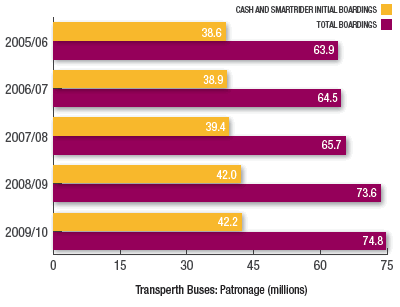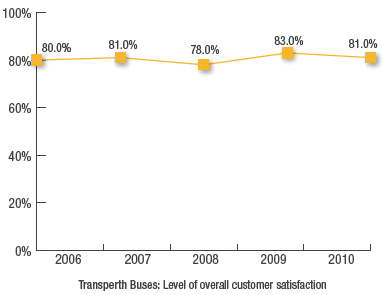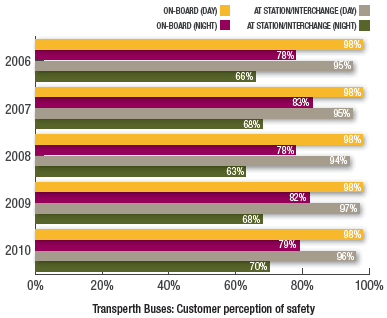Transperth buses
Transperth’s bus services are divided into 11 geographic contract areas which are periodically subject to competitive tender. Currently, services in these 11 areas are operated by three contractors:
- Path Transit (Marmion-Wanneroo and Morley contracts, with the Joondalup CAT contract forming part of the Morley contract).
- Swan Transit (Canning, Kalamunda, Midland, Southern River, Claremont, and Belmont contracts).
- Southern Coast Transit (Rockingham, Fremantle-Cockburn and Perth CAT contracts, with the Fremantle CAT contract part of the Fremantle-Cockburn contract).
In 2009/10, our bus system operated 305 standard timetabled bus routes and 398 school routes. On a typical weekday this involved operating 11,261 standard and 398 school service trips. Accessible buses are always used on 112 of the standard routes. A bus service frequency of 20 minutes or better is provided all day on most major corridors, with higher frequencies in peak periods.
The year’s developments
- Redevelopment of Kalamunda bus station completed.
- Redevelopment of Karrinyup bus depot completed.
- Commenced redevelopment of Mirrabooka bus station.
- Service improvements during the year:
- Introduced high-frequency services (Routes 888 and 885) between Wellington Street bus station (WSBS), Edith Cowan University (ECU) and Mirrabooka regional centre via Alexander Drive and Fitzgerald Street to cater for growing demand along this corridor. Route 998 operates between Mirrabooka bus station and WSBS; Route 885 provides additional capacity between WSBS and ECU.
- Canning Highway service upgrade: Route 105 peak service to provide additional capacity along Canning Highway between Applecross and the Causeway; Route 111 to provide additional peak and peak-shoulder trips between Fremantle Station and Esplanade Busport via Kwinana Freeway; additional Saturday services on Route 106 on Canning Highway.
- Introduction of a trial service between Rockingham Station and Rockingham City Shopping Centre to better cater for the needs of seniors living in the Hefron Street area.
- Service extension on Routes 483, 484, 586, 589, 597
In 2009/10, the Transperth bus network covered 52.340 million service kilometres, an increase of 0.7 per cent over 2008/09’s 51.997m. In the five-year period to 2009/10, service kilometres have increased by 6.5 per cent.
Total network capacity in 2009/10 was 3677m passenger place kilometres, a reduction of 0.4 per cent compared with 3690.9m passenger place kilometres provided in 2008/09. The average capacity of the fleet fell by 1 per cent to 70.25 in 2009/10 from 70.98 in the previous year. This was due to the increasing proportion of CNG buses in the fleet - CNG buses have a marginally lower capacity than diesel buses. As at June 30, we had 521 CNG buses in our 1146-vehicle fleet (45 per cent). A further 96 CNG buses will be delivered in 2010/11 as the existing bus supply agreement concludes.
During the year, a CNG refuelling facility was constructed at Karrinyup bus depot and commissioned in November 2009.
The safety audits of our bus contractors continued in line with standard AS 4801-OSH Management Systems. Each depot was audited at least once with other documented site visits occurring throughout the year. These regular audits and inspections have generated improved safety management systems and safety focus, and our contractors’ Lost Time Injury (LTI) rate continues to be well below the industry standard.
- Swan Transit was re-certified to AS4801 in May 2009 (valid to May 2012). Swan Transit has an LTI rate of 2.0.
- Path Transit was re-certified to AS4801 in August 2009 (valid to August 2012) and has achieved the WorkSafe Platinum Award. Path Transit’s LTI rate is 1.3.
- Southern Coast Transit was re-certified to AS4801 in January 2008 (valid to January 2011) and has also achieved the WorkSafe Platinum Award. Southern Coast Transit’s LTI rate is 2.7.
During the year, we continued to upgrade our workshop facilities to ensure that maintenance of our CNG-fuelled buses is carried out in a safe environment. The program includes gas detection sensors, alarm systems, extraction fans and the infrastructure to support the maintenance of these units including safe access ladder systems and roof-top walkways.
Cost of the service
The total cost of operating Transperth bus services in 2009/10 was $318.835 million, up 5 per cent from $303.532m last year. Operating costs rose 5.5 per cent to $268.470m from $254.501m in 2008/09. The cost increase was due to an increase of more than seven per cent in bus driver wages, the cost impact of the new CNG refuelling facility at Karrinyup, and the cost of the extra 343,695 service kilometres operated during the year.
Patronage
In 2009/10, total boardings on Transperth bus services were 74.756 million, up 1.6 per cent from 73.550m in 2008/09, when a 12 per cent increase was achieved following the start of services on the Mandurah Line. Cash and SmartRider initial boardings edged up 0.6 per cent to 42.235m from 41.963m in 2008/09 but fare-paying boardings slipped 5.1 per cent, reflecting the full-year impact of free travel for seniors, aged and disability pensioners.
Comparing fare-paying boardings over the three months to June 30, on a like-for-like basis, showed a 1.2 per cent increase in 2010 at 9980.7m boardings compared with 9865.5m in 2009.
Contract areas recording significant increases in cash and SmartRider initial boardings were Southern River (7.9 per cent) and Midland (3.5 per cent), while Canning achieved a 1.4 per cent increase. Boardings fell in Belmont (-2.3 per cent), Kalamunda (-1 per cent) and Morley (-0.3 per cent) while other contract areas recorded marginal increases. On the Circle Route (a high-frequency service connecting major shopping centres, hospitals, universities, schools and colleges) boardings edged up 0.3 per cent.
Road congestion, particularly in peak periods and the lack of significant bus priority measures on major roads in Perth continue to impact on service reliability and may affect patronage on Transperth bus services.
In 2009/10 Transperth buses operated 52.340 million service kilometres, up 0.7 per cent from 51.997m in 2008/09. On a per service kilometre basis, cash and SmartRider initial boardings remained unchanged at 0.807 between 2008/09 and 2009/10, while total boardings increased by 1.0 per cent to 1.428 from 1.415.
Passenger satisfaction
The 2010 PSM showed a marginal decline in the proportion of Transperth bus users who expressed overall satisfaction with the system - 81 per cent compared with 83 per cent in 2009. Poor results in the Morley contract area and concerns over personal safety on board at night were key factors in the downturn.
The importance rating of the key service characteristics (other than passenger safety) and their respective levels of satisfaction are shown in the accompanying table. In 2010, users identified “service frequency peak times” as a key service characteristic, replacing “service frequency weekends”. The satisfaction rating for “cleanliness on board” was unchanged and for “shelter provided at the bus stop” it went up, but for the other main characteristics, the satisfaction rating eased slightly.
| Service characteristic | Importance rating (%) | Satisfaction (dissatisfaction) (%) | ||
|---|---|---|---|---|
|
2009 |
2010 |
2009 |
2010 |
|
|
Punctuality |
65 |
65 |
83 (8) |
79 (10) |
|
Cost of fares |
61 |
59 |
66 (7) |
65 (8) |
|
Service frequency weekdays |
64 |
58 |
69 (20) |
68(20) |
|
Shelter provided at the bus stop |
59 |
54 |
71 (22) |
72 (20) |
|
Cleanliness on board |
55 |
52 |
91 (3) |
91 (3) |
|
Speed of the trip |
48 |
52 |
92 (3) |
89 (4) |
|
Availability of seats |
49 |
48 |
92 (5) |
91 (5) |
|
Service frequency peak times |
42 |
77 (14) |
||
Passenger safety
In the 2010 PSM, bus users were asked: “How safe do you generally feel from personal interference or threat from other passengers?” The accompanying graph shows the proportion of respondents who “always feel safe” or “usually feel safe” at the specified times/locations on the bus network.
Results for the past five years show that almost all passengers generally feel safe on board our buses and at station/interchanges during the day. Though the proportion of users who feel safe at night on board fell to 79 per cent from 82 per cent, the proportion of users who felt safe at night at station/interchanges increased to 70 per cent from 68 per cent.
The security concerns expressed by passengers who travel on our buses at night have been given particular attention. While noting that most passenger security concerns are based on perception rather than actual events, we focussed even further attention on improving bus system security.
In addition to security officers at major bus stations, mobile patrols, CCTV at bus stations and on all new buses, the following improvements were implemented in 2009/10:
- Increased mobile security patrols with the addition of six new cars to the fleet of 11 patrol cars resulting in a 121 per cent increase in the number of man-hours attributable to mobile security.
- Targeting hotspots with security resources using information from the comprehensive security incident database maintained by Transperth to record all security incidents by location/route.
- Launched Operation Cleanskin in response to public concern and escalating costs to repair graffiti vandalism to bus rolling stock. Under this program, selected “cleanskin” buses are closely and regularly monitored and if evidence of scratching is found, an immediate CCTV review is undertaken to identify the perpetrator and refer the matter to Police for investigation.
- Upgraded CCTV at bus stations.
- Installed driver duress alarms on all buses.
- Installed security cabs on all buses used after 6pm.
Major initiatives for 2010/11
- Upgrade Mirrabooka bus station.
- Service improvements:
- Frequency and/or operating hours of the Perth CAT services (Red, Yellow and Blue)
- Frequency of Beaufort Street services (routes 22,67and 68)
- A high-frequency spine on Ellenbrook and Morley services (routes 955 and 956) and changes to the feeder bus network
- Frequency of Guildford Road services (routes 41,42,43,44 and 48) in two stages - stage 1 to improve Sunday services and stage 2 to upgrade weekday services
- Extension of route 19 to serve Dog Swamp Shopping Centre
- Upgrade weekday inter-peak and peak shoulder services on Scarborough Beach Road, Wanneroo Road and Cambridge Street.
- Trial of bus service linking Armadale Station and Cockburn Station.


